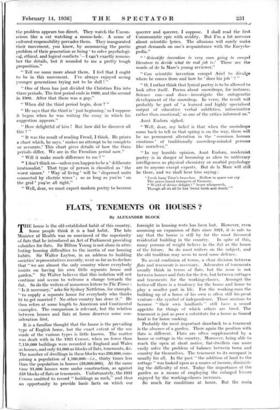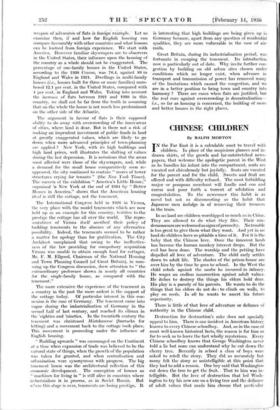FLATS, TENEMENTS OR HOUSES ?
By ALEXANDER BLOCK THE house is the old-established habit of this country. Some people think it is a bad habit. The late Minister of Health was so convinced of the superiority of flats that he introduced an Act of Parliament providing subsidies for flats. Sir Hilton Young is not alone in attri- buting housing difficulties to the inertia of our housing habits. Sir Walter Layton, in an address to building societies' representatives recently, went so far as to declare that "'we are almost the only country where everybody insists on having his own little separate house and garden." Sir Walter believes that this isolation will not continue and seems to welcome a change towards the flat. So clothe writers of numerous letters to The Times : "Is it necessary," asks Sir Sydney Nettleton, for example, " to supply a separate house for everybody who thinks fit to get married ? No other country has done it." He then refers at some length to American and Continental examples. The comparison is relevant, but the relation between houses and flats at home deserves some con- sideration first.
It is a familiar thought that the house is the prevailing type of English home, but the exact extent of the use made of the various types is little known. The matter was dealt with in the 1921 Census, when no fewer than 7,158,000 buildings were recorded in England and Wales as houses, and only 84,000 as blocks of flats, tenements, &c. The number of dwellings in these blocks was 290,000, com- prising a population of 1,100,000—i.e., thirty times less than the population in houses (33,000,000). At the same time 91,000 houses were under construction, as against 358 blocks of flats or tenements. Unfortunately, the 1031 Census omitted to record " buildings as such," and thus an opportunity to provide basic facts on which our foresight in housing rests has been lost. However, even assuming an expansion of flats since 1921, it is safe to say that the house is still by far the most favoured residential building in the country. In spite of this, many persons of weight believe in the flat as the house of the future. So do most writers on the subject, and the old tradition may seem to need some defence.
To avoid confusion of terms, a clear division between flats and tenements is necessary. Advocates of tenements usually think in terms of flats, but the issue is not between houses and flats for the few, but between cottages and tenements for the working-classes. Amongst the better-off there is a tendency for the house and home to play a smaller part in life. For the working-man the building up of a home of his own is often still his great venture—the symbol of independence. Those anxious to become " their own landlords " still have a sound appetite for things of which others arc tired. The tenement is just as poor a substitute for a house as tinned food is for home cooking.
Probably the most important drawback to a tenement is the absence of a garden. There again the position with flats is different. Flats arc often supplemented by a house or cottage in the country. Moreover, being able to reach the open at short notice, flat-dwellers can more easily solve the problem of balance between town and country for themselves. The tenement to its occupant is usually his all. In the past " the addition of land to the cottage " was looked upon as a source of income, diminish- ing the difficulty of rent. Today the importance of the garden as a means of employing the enlarged leisure enjoyed by the working-classes increases.
So much for conditions at home. But the main, weapon of advocates of flats is foreign. exatnple:- Let us examine then, if and how far English housing can compare favourably with other countries and what lessons can be learned from foreign experience. We start with America. However familiar skyscrapers are to observers in the United States, their influence upon the housing of the country as a whole should not be exaggerated. The percentage of one-family houses in the United States, according to the 1930 Census, was 76.4, against 89 in England and Wales in 1921. Dwellings in multi-family houses (i.e., houses built for three or more families) num- bered 12.1 per cent. in the United States, compared with 4 per cent. in England and Wales. Taking into account the increase of fiats between 1921 and 1930 in this country, we shall not be far from the truth in assuming that on the whole the house is not much less predominant on the other side of the Atlantic.
The argument in favour of flats is their supposed ability to do away with overcrowding of the inner areas of cities, where land is dear. But is there not a risk of making an imprudent investment of public funds in land at greatly exaggerated values, which are likely to go down when more advanced principles of town-planning are applied ? New York, with its high buildings and high land prices, well illustrates the shifting of values during the last depression. It is notorious that the areas most affected were those of the skyscrapers, and, while a demand for the small house comparatively soon re- appeared, the city continued to contain " scores of tower structures crying for tenants " (the New York Times). The success of the exhibition " America's Little House," organised 'n New York at the end of 1934 by " Better Homes in America," shows that the American housing ideal is still the cottage, not the tenement.
The International Congress held in 1926 in Vienna, the very place with the model tenements which are now held up as an example for this country, testifies to the prestige the cottage has all over the world. The repre- sentatives of Vienna itself ascribed their policy of building tenements to the absence of any alternative possibility. Indeed, the tenements seemed to be rather a matter for apology than for gratification. The City Architect complained that owing to the ineffective- ness of the law providing for compulsory acquisition Vienna was unable to obtain enough land for cottages'. Mr. F. M. Ellgood, Chairman of the National Housing and Town Planning Council (of Great Britain), in sum- ming up the Congress discussion, drew attention to " the extraordinary preference shown in nearly all countries for the single-family house, as compared with the tenement." • The more extensive the experience of the tenement in a country in the past the more ardent is the support of the cottage today. Of particular interest in this con- nexion is the case of Germany. The tenement came into vogue during the industrialisation of Germany in the second half of last century, and reached its climax in the 'eighties and 'nineties. In the twentieth century the tenement was christened Mietskasernc (barracks for letting) and a movement back to the cottage took place. This movement is proceeding under the influence of English housing.
" Building upwards " was encouraged on the Continent at a time when expansion of trade was believed to be the natural state of things, when the growth of the population was taken for granted, and when centralisation and urbanisation were synonymous with progress.. The big tenement house was the architectural reflection of this economic development. The conception of houses as " machines for living in " is still alive in countries where industrialism is in process, as in Soyiei Russia. Ant where this stage is over, tenements arc loin* prestige. It is interesting that high buildings are being given up in Germany because, apart from any question of residential qualities, they are more vulnerable in the case of air- raids.
Great Britain, during its industrialisation period, was fortunate in escaping the tenement. Its introduction now is particularly out of date. Why invite further con- gestion by building on old urban sites chosen under conditions which no longer exist, when advance in transport and transmission of power has removed many of the limitations which caused the congestion, and we are in a better position to bring town and country into harmony ? There are cases when flats are justified, but the real cure against overcrowding is decentralisation- i.e., so far as housing is concerned, the building of more and better houses in the right places.















































 Previous page
Previous page